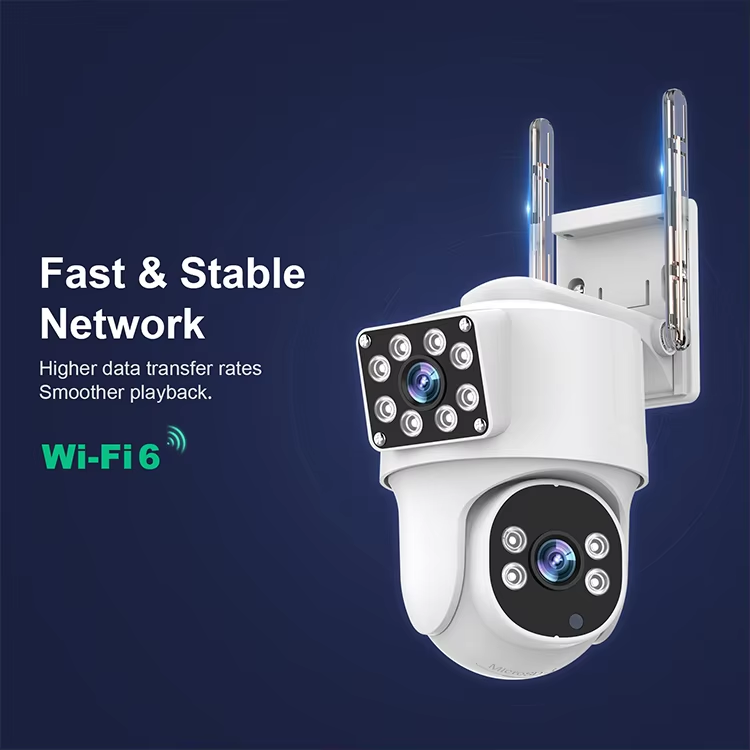ますます複雑化する今日のセキュリティ状況において、ビデオ監視は、家庭と企業の両方における包括的な保護戦略の重要な要素となっています。調査によると、目に見える監視システムを導入している物件では、不法侵入が最大50%減少しており、適切なシステムを導入することで、脅威の抑止や事件発生時の記録に大きな違いが生まれることが浮き彫りになっています。テクノロジーの急速な進歩に伴い、従来のアナログカメラから高度な分析機能を備えたAI搭載の洗練されたIPシステムまで、消費者が利用できる選択肢は劇的に広がっています。機能、予算、特定のセキュリティ・ニーズの間で完璧なバランスを見つけるには、いくつかの重要な要素を慎重に検討する必要があります。 ガイド.
効果的なビデオ監視システムを構成するコンポーネントとは?
市場に出回っている無数の監視カメラの選択肢に圧倒されたと感じたことはないだろうか。私はこれまで何百人ものクライアントと仕事をしてきましたが、最初は何が必要かを正確に見極めるのに苦労しました。実は 正しい監視システム 最も高価なカメラを購入することだけが目的ではなく、それぞれの状況に最適なものを見つけることが重要なのだ。
監視システムのセットアップを成功させる秘訣は、さまざまなコンポーネントが互いにどのように補完し合っているかを理解することにあります。私はプロのインテグレーターとして、最高のシステムはお客様の環境、脅威、目的に合わせて正確に調整されていることをお伝えできます。
カメラの選択システムの目
監視の旅は、適切なカメラタイプを選ぶことから始まります。屋内では ドーム型IPカメラ は、洗練された控えめなデザインで目立たない監視を提供します。視認性が重要な屋外の境界では、弾丸カメラは耐候性を提供しながら、明白な抑止力を作成します。
環境への配慮も忘れてはならない!太陽の光が降り注ぐ中庭の近くに設置するカメラと、薄暗い倉庫を監視するカメラでは、必要な機能が異なります。暗い場所では、赤外線機能を備えたカメラを使用すれば、最も重要なときに暗闇に取り残されることはありません。
記録と保存システムのメモリ
どんなに優れたカメラでも、適切な録画インフラがなければ意味がありません。ネットワーク・ビデオ・レコーダー(NVR)と PoE IPカメラ は、従来のDVRシステムに比べて設置が簡単で、柔軟性に優れています。私のクライアントの多くは、ニーズが高まるにつれてシステムを簡単に拡張できることを高く評価しています。
ストレージの決定には、容量とアクセシビリティのバランスを取る必要がある。以下はその実際的な内訳である:
| 収納タイプ | メリット | 考察 |
|---|---|---|
| ローカル(HDD) | 迅速なアクセス、一回限りのコスト | 身体的脆弱性、限られた能力 |
| クラウドベース | オフサイト・セキュリティ、リモート・アクセス | 月額費用、必要な帯域幅 |
| ハイブリッド | 冗長性、柔軟性 | 初期設定の複雑さ |
解像度と分析システムのインテリジェンス
解像度の要件は用途によって大きく異なる。顔の特徴やナンバープレートを識別する場合、 4K IPカメラ は、必要なディテールを提供する。しかし、一般的なエリアのモニタリングであれば、1080pで十分かもしれませんし、ストレージの予算も節約できます。
最新のアナリティクスが、受動的な録画を能動的なセキュリティに変えます。動体検知、人物カウント、ライン交差検知などの機能は、ノイズをフィルタリングし、重要なものをハイライトするのに役立ちます。私は、関連するイベントのみにフラグを立てるスマートなアナリティクスを導入することで、クライアントのレビュー時間を70%短縮するお手伝いをしてきました。
これらのコンポーネントをつなぐネットワーキング・インフラは、信頼性が高くセキュアでなければならない。システムは、その最も弱いリンク(多くの場合、ネットワークそのもの)と同じ強さしかありません。以下のような専門プロバイダーとの連携をご検討ください。 JERテクノロジー堅牢で安全な監視ネットワークの構築方法を理解している。
目標は最先端の技術を手に入れることではなく、各コンポーネントが調和して機能するシステムを構築し、お客様固有のセキュリティ課題に対処することであることを忘れないでください。特定の状況についてガイダンスが必要ですか? セキュリティの専門家に連絡する あなたのユニークなニーズを評価する手助けをすることができる。

具体的な監視の必要性をどのように評価するか?
私はこの業界で長年にわたり、何百件ものセキュリティ評価を実施してきましたが、この重要な評価ステップを省略することは、設計図なしに家を建てるようなものです。設計図なしに家を建てるようなものです。おそらくそうではないでしょう。
監視のニーズは環境によって大きく異なるのが現実です。小売店で有効なものが、倉庫やオフィス、家庭で必ずしも有効とは限りません。本当に必要なものを正しく評価する方法を説明しましょう。
資産と脆弱性の特定
自問自答することから始めよう:「私は実際に何を守ろうとしているのか?私はいつもクライアントに、自分のスペースを歩いて、文字通り最も価値のある資産を指摘するようアドバイスしている。それは在庫ですか?機密文書?侵入口?それぞれに異なるアプローチが必要です。
次に、それぞれの状況に特有の脅威を検討する。小売店では主に万引きやレジの盗難を心配するかもしれませんし、倉庫では在庫の動きを追跡し、不正アクセスを防ぐことに重点を置くかもしれません。あるクライアントを支援したことがある。そのクライアントは、施設全体に高価なカメラを設置していたが、実際の脆弱性ポイントである搬入口を完全にカバーしていなかった!
戦略的にスペースをマッピングする
簡単な間取り図を作成し、これらの重要な要素に印をつける:
- 監視が必要な出入口
- 資産価値の高い場所
- 死角と隠れた部分
- 通常の交通パターン
このマッピング作業によって、しばしば驚くべき洞察が明らかになる。あるクライアントは、5台のカメラが何もない廊下を監視している一方で、サーバー・ルームはまったく監視されていないことを発見した!
| ゾーン・タイプ | リスクレベル | 推奨カバレッジ |
|---|---|---|
| 出入り口 | 高い | 高解像度、顔のディテール機能 |
| 現金/貴重品保管 | クリティカル | マルチアングル対応、高度な分析 |
| 一般地域 | ミディアム | 基本的な動体検知、標準解像度 |
コンプライアンス要件の検討
業界や場所によって大きく異なるが、法的な考慮も忘れてはならない。医療施設ではセキュリティとHIPAA要件のバランスを取る必要がありますし、住宅用システムでは敷地の境界を尊重する必要があります。私は、カメラの設置がプライバシーに与える影響を理解していなかったために、企業が多額の罰金に直面するのを見てきました。
のようなスペシャリストと協力している。 IPカメラ専門メーカー は、規制基準を満たす機器を確実に入手しながら、これらの要件をナビゲートするお手伝いをいたします。
現実的な予算
あなたの予算計画は、単に先行購入だけにとどまらないはずです。私はいつもクライアントに、総費用には以下が含まれることを念押ししている:
- 以下のような信頼できる筋からの初期機器購入 JERテクノロジー
- 専門家による取り付け(特に器用な人を除く)
- 継続的なメンテナンスとソフトウェア・アップデート
- ニーズの変化に伴う拡張コストの可能性
- 最終的な交換費用(通常5~7年)
効果的なアプローチのひとつは、リスクの高い分野から優先順位をつけることです。必要不可欠な PoE IPカメラ 重要なポイントをカバーし、予算の許す限りシステムを拡張していく。この段階的なアプローチは、最初からすべてを不十分にカバーしようとするよりも良い結果をもたらすことが多い。
具体的な評価でお困りですか?多くのプロバイダーは、お客様独自のニーズを評価するためのコンサルティングサービスを提供しています。セキュリティ専門家への働きかけ 長い目で見れば、大きな失敗を避けることができる。

どの技術的特徴を優先すべきか?
セキュリティ・ニーズを特定した後の次の課題は、技術仕様の海を渡り歩くことです。私は何年もかけて、クライアントが必要な機能とマーケティング的な宣伝文句を区別できるように支援してきましたが、ここで学んだことは、技術的なベルやホイッスルがすべてセキュリティの向上につながるわけではないということです。
決断自分のスイートスポットを見つける
カメラの解像度は、おそらく最も誤解されている仕様です。画素数が多ければ良いというわけではありません!基本的なエリアの監視であれば、標準的な1080pのカメラで十分にカバーできることが多い。しかし、顔の詳細やナンバープレートを撮影する必要がある場合は、1080pのカメラで十分です、 4K IPカメラ 特に広範囲をカバーする場合には不可欠となる。
ある小売業のクライアントは、あらゆる場所に4Kを導入しようと主張したが、ストックルームのセキュリティ上の利点はほとんど得られないまま、ストレージのコストが3倍になっていることに気づいた。その一方で、実際に細部が重要なレジには専用カメラを設置しなかった!
| 決議 | 理想的なアプリケーション | ストレージへの影響 |
|---|---|---|
| 1080p (2MP) | 一般的なモニタリング、小規模エリア | 標準(ベースライン) |
| 4MP | エントリー・ポイント、ミディアム・スペース | 2倍のストレージが必要 |
| 4K (8MP) | 識別、広域 | 4倍のストレージが必要 |
解像度よりも重要なのはセンサーの品質だ。のトップクラスの2MPカメラは 信頼できるメーカー は、厳しい照明条件下では、常に格安4Kカメラを凌駕する。
インテリジェントな動体検知:誤報をなくす
誤作動の連続によるアラームの疲労ほど、セキュリティ・システムを早く弱体化させるものはありません。最新の動体検知は、施設に近づく人と風に揺れる木の枝を区別できるインテリジェントなアルゴリズムを使用する必要があります。
単純なピクセル変化検出ではなく、物体分類(人、車両、動物)を伴うゾーンベースの検出を提供するシステムを探してください。この技術により、誤警告を最大90%減らすと同時に、本物のセキュリティイベントを確実に通知します。
リモートアクセス:セキュリティと利便性の融合
監視システムをリモートで監視・管理する機能は、贅沢品から必需品へと進化しました。しかし、この利便性は、実装が不十分な場合、潜在的なセキュリティの脆弱性を生み出します。
プラットフォームの提供に優先順位をつける:
- エンド・ツー・エンドの暗号化
- 多要素認証
- 定期的なファームウェア・アップデート
- 監査ログがユーザーアクセスを追跡
保管とリテンション見落とされがちな計算
ストレージの要件は、経験豊富なセキュリティの専門家でさえも驚かせることがある。単一の ドーム型IPカメラ 4Kで連続録画すると、年間10TB以上のストレージを消費する可能性がある!スマートストレージオプションを提供するシステムを検討しましょう:
- モーションベースの録画で、関連するイベントのみをキャプチャ
- カメラごとに異なる保存期間(重要なエリアではより長い保存期間)
- ローカルとクラウドの両ソリューションを活用した階層型ストレージ
複数の拠点を持つ企業向け、 JERテクノロジー は、分散したサイト間でのストレージ管理をより簡単にする統合管理プラットフォームを提供する。
高度な分析:投資に値するか?
AIを活用したアナリティクスは、受動的な監視を能動的なセキュリティに変えることができますが、その分、高価格になります。これらの機能は、特定のセキュリティ目標に沿った場合にのみ、実質的なROIを実現します。
顔認識や行動分析に投資する前に、これらの機能が特定のセキュリティ課題にどのように対応するかを明確に定義してください。どの機能が本当に自社のニーズに対応しているのかが不明な場合は、以下を参照してください、 セキュリティ・プロフェッショナルとのコンサルティング は、あなたの環境に合わせた貴重なガイダンスを提供することができます。

なぜスケーラビリティが重要なのか?
顧客が犯す最も高価な過ちのひとつは、ニーズに合わせて成長できない監視システムに投資することです。私は、導入後わずか数年でセキュリティ・インフラ全体を交換するという、あまりにも多くの企業が痛い目に遭っているのを目の当たりにしてきました。
スケーラビリティは単なる技術的な流行語ではありません。セキュリティ環境は絶えず進化しており、監視システムもそれに対応する必要があります。
拡張可能な土台から始める
拡張性のあるシステムの中核は、成長余地のある録画インフラである。探す ネットワークビデオレコーダー (NVR) 現在必要な台数よりも多くのカメラをサポートしています。私は通常、将来の拡張のために少なくとも25~30%のヘッドルームを推奨しています。最初に PoE IPカメラ カメラ8台のシステムは、わずか2年で12台、16台へと拡大した。
| システム・サイズ | 初期投資 | 拡張コスト(拡張可能) | 再調達コスト(ノンスキャラブル) |
|---|---|---|---|
| 小型(カメラ4~8台) | $1,500-$3,000 | カメラ1台につき$250~$500 | $2,000~$4,000フルシステム |
| 中型(16~32台) | $5,000-$12,000 | カメラ1台につき$400~$700 | $7,000~$15,000フルシステム |
オープンスタンダードの採用
独自システムは拡張性の敵だ。私は、異なるメーカー間の互換性を保証するONVIF標準をサポートするプラットフォームを常に推奨しています。このアプローチにより、ベンダーロックインを防ぎ、インフラ全体を交換することなく、ニーズに応じて特殊なカメラを組み込むことができます。
のような評判の良いメーカーである。 JERテクノロジー これらのオープンスタンダードを念頭に置いて製品を設計しているため、既存のシステムや将来の拡張とのシームレスな統合が可能です。
将来を見据えたストレージ・ソリューション
保存期間の長期化、カメラの高解像度化、カメラの追加導入により、ストレージ要件は時間の経過とともに必然的に増大します。以下のようなシステムを探してください:
- 拡張可能なドライブベイまたは外付けストレージ対応
- 新しい圧縮規格(H.265/H.266)のサポート
- ハイブリッド・ストレージ・オプション(ローカル+クラウド)
あるクライアントは、保存要件が30日から90日に増えたときにシステム全体を交換するのではなく、ストレージ・ドライブを追加するだけで済むスケーラブルなNVRを選択することで、$8,000ドル以上を節約しました。
統合能力
今日の ドーム型IPカメラ は、明日の入退室管理システムやビル管理システムと統合する必要があるかもしれません。先進的な企業は、堅牢なAPIサポートと統合機能を備えた監視プラットフォームを選択します。
複数拠点を持つ企業にとって、企業向け動画管理は非常に重要です。このようなプラットフォームでは、1つの拠点から始めて、徐々に追加拠点を統合管理下に置くことができます。
クラウドの考察
クラウドに接続された監視システムは、特に大きな成長が見込まれる企業にとって、ユニークなスケーラビリティの利点を提供する。これら システムは通常、カメラを追加できる しかし、帯域幅の要件は慎重に評価する必要がある。
どのようにするか議論する必要がある 4K IPカメラ スケーラブルなセキュリティ戦略に適合できるか? セキュリティの専門家に連絡する このようなシステム設計は、組織を制限するのではなく、組織とともに成長するシステムを設計する手助けをすることができる。
どのようなインストールとサポートを考慮すべきか?
完璧なカメラ、録画機器、ストレージ・ソリューションを選んでも、適切な設置やサポートがなければ、監視システムは最悪の瞬間に故障してしまうかもしれません。私は、設置にかかる費用を節約しようとした結果、この教訓を痛感したクライアントを数多く見てきました。
DIYの誘惑とプロの施工の現実
DIYの魅力は理解できる。あの説明書を読むと、すべてがだましだまし簡単に見える。基本的な家庭用セットアップの場合、2~3 ワイヤレスカメラセルフ・インストールならうまくいくかもしれない。しかし、システムが複雑になればなるほど、潜在的な落とし穴も増える。
プロのインストーラーは、重要な専門知識を持っている:
- 死角をなくし、カバー範囲を最適化する戦略的なカメラ配置
- いたずらや環境破壊を防ぐ適切な取り付け
- 信号劣化を防ぐ正しい配線の実装
- ビデオの品質と帯域幅の制約のバランスをとるネットワーク構成
| インストレーション・アプローチ | 最適 | リスク要因 |
|---|---|---|
| DIYインストール | 小規模住宅、カメラ1~4台 | ポジショニングエラー、ネットワークの脆弱性 |
| プロフェッショナル・インストレーション | ビジネス、マルチカメラシステム | イニシャルコストが高く、インストーラーの質にばらつきがある |
私は個人的に、プロによる設置がもたらす違いを目の当たりにしてきた。 セキュリティ専門家.カメラは同じだったが、戦略的な配置がすべての違いを生んだ。
継続的なメンテナンス隠れた要因
完璧に設置されたシステムにもメンテナンスは必要です。監視システムは単なるハードウェアではなく、継続的なセキュリティサービスであり、注意が必要です。
しっかりとしたメンテナンス計画には、以下が含まれるはずだ:
- セキュリティ脆弱性を修正するための定期的なファームウェアアップデート
- カメラレンズとハウジングの物理的クリーニング
- 動体検知とアラート機能の定期テスト
- ストレージ管理と容量監視
- ネットワーク・セキュリティ・プロトコルの検証
と驚く顧客もいる。 ドーム型IPカメラ 定期的な清掃が必要です。ドームにほこりがたまると、時間の経過とともに画質が著しく劣化します!
テクニカルサポートセキュリティのライフライン
テクニカル・サポートの質は、あなたの監視体験を左右します。どのシステムにもコミットする前に、サポート体制を調査してください:
- サポートは年中無休ですか、それとも営業時間内だけですか?
- クリティカルな問題に対する一般的な対応時間は?
- 特定の機器に精通した知識豊富な技術者によるサポートが提供されているか。
- 問題を迅速にトラブルシューティングするためのリモート診断は利用可能か?
を使用するビジネスクリティカルなアプリケーションの場合 4K IPカメラ またはコンプレックス PoE IPカメラ ネットワークでは、迅速なサポートへのアクセスは単に便利なだけでなく、セキュリティの継続性を維持するために不可欠です。
保証の保護細則を読む
保証条件はプロバイダーによって大きく異なる。標準的な "1年間のハードウェア保証 "を超えて理解するために見てください:
- 設置工事の技量が補償の対象となるかどうか
- オンサイトサービスが含まれる場合、または欠陥のある機器を発送しなければならない場合
- 特定のコンポーネントの保証内容(電源やハードドライブの保証期間が短い場合があります。)
- 重要なシステムの保証延長の可否
のような評判の良いメーカーである。 JERテクノロジー これは、製品の信頼性に対する自信の表れである。
お客様の環境に合わせたインストールとサポートオプションのガイダンスが必要ですか? セキュリティの専門家に連絡する あなたのユニークな要件を評価するのに役立ちます。

ビデオ監視技術の比較
私がこの業界で15年以上働いてきた間に、監視技術の状況は劇的に変化した。最初のアナログCCTVシステムを設置したときのことを今でも覚えている。かさばるカメラ、いたるところに張り巡らされた同軸ケーブル、被写体を特定するのが、ピースの半分が欠けているパズルを解くような気分になるような録画品質だった。今日のオプションは、機能を大幅に向上させる一方で、より複雑な判断ポイントを生み出している。
アナログとIP:根本的な違い
従来のアナログ・システムは、特定のシナリオではまだその役割を担っている。一般的には、初期費用が手頃で、設定も簡単なため、基本的なセキュリティ・ニーズを持つ予算重視のユーザーには魅力的だ。しかし、解像度の上限が1080p程度であること、統合オプションが限られていること、インテリジェント機能がほとんどないことなど、その限界はすぐに明らかになる。
対照的に、現代の IPカメラシステム ネットワークに直接接続し、飛躍的に大きな機能を提供します。これらのシステムは以下を提供する:
- 優れた解像度(最大4Kおよびそれ以上)
- 物体検出のような高度な分析
- 柔軟な展開オプション
- 成長する組織のための優れたスケーラビリティ
近年、コストの差は大幅に縮まっています。私は、多くのクライアントがアナログからIPに移行する際に、驚くほどわずかな予算増で、しかも劇的に改善されたセキュリティ成果を実現できるよう支援してきました。
| テクノロジー | 決議 | 設置の複雑さ | アナリティクス |
|---|---|---|---|
| 伝統的なアナログ | 最大1080p | 中程度 | 非常に限定的 |
| HDオーバーコアックス | 最大4K | 中程度 | 限定 |
| IPカメラ | 最大12MP | より高い | 上級 |
有線と無線:信頼性と柔軟性
有線監視カメラと無線監視カメラの論争は、実際には優先順位の問題である。有線接続は PoE IPカメラ は、セキュリティ重視のアプリケーションに不可欠な、揺るぎない信頼性と一貫したパフォーマンスを提供します。1本のイーサネット・ケーブルで電源とデータの両方を供給するため、電源ケーブルとビデオ・ケーブルを別々に必要とする従来のシステムに比べ、設置が簡素化されます。
ワイヤレス・オプションは、配線が困難な場所にも柔軟に対応できるが、干渉や信号の制限による信頼性の懸念が生じる可能性がある。私は通常、ほとんどのクライアントにハイブリッド・アプローチを推奨している。 ワイヤレスカメラ ケーブルの敷設が不可能な厳しい場所での使用に適しています。
オンプレミスとクラウド:コントロールと利便性
ストレージと処理のアーキテクチャは、もうひとつの重要な決定ポイントである:
オンプレミス・システムは、すべてをローカルに保存するため、データを完全に管理でき、月額料金も不要です。しかし、録画機器や社内のIT専門家への先行投資が必要になります。
クラウドベースのソリューションは、ストレージと処理をリモートサーバーに移行し、オンサイトのハードウェア要件を削減し、複数拠点の管理を簡素化します。私のクライアントの多くは、クラウド・システムによって次のような監視が可能になることを高く評価している。 ドーム型IPカメラ 単一のインターフェイスから複数の施設にまたがる
この場合も、ハイブリッド・アプローチが最良の結果をもたらすことが多い。重要な映像については、オンプレミスの録画とクラウド・バックアップを導入することも考えられる。お客様の環境に最適なテクノロジーについてアドバイスが必要ですか? セキュリティの専門家に連絡する あなたの特定のニーズを評価することができる。
長年の導入実績から私が共有できる最も重要な洞察は、セキュリティの目的、技術的能力、予算の制約に合致するものであれば、何でも「最良」のテクノロジーであるということです。高解像度 4K IPカメラ 基本的なモニタリングには過剰かもしれないが、詳細な識別を必要とするアプリケーションには不可欠である。
結論
適切なビデオ監視システムを選択するには、セキュリティの脆弱性、環境条件、技術的要件、予算の制約などを十分に考慮する必要があります。徹底したニーズ評価から始め、適切な解像度や信頼性の高い動体検知など、必要不可欠な機能に優先順位を付け、拡張性や継続的なサポートなどの要素を考慮することで、不必要な複雑さや費用をかけずに効果的な保護を提供するシステムを導入することができます。基本的なモニタリングのためのシンプルなソリューションであれ、高度な分析機能を備えたAI搭載の先進的なシステムであれ、最も重要な要素は実際のセキュリティ目標との整合性です。機器に投資する前に、時間をかけて包括的なセキュリティ戦略を策定し、特定のシナリオに基づいて客観的なガイダンスを提供できるセキュリティの専門家に相談することを検討してください。適切なアプローチをとることで、監視システムは事件の記録映像だけでなく、脅威を抑止し、安心感を与える能動的な保護を提供することができます。


